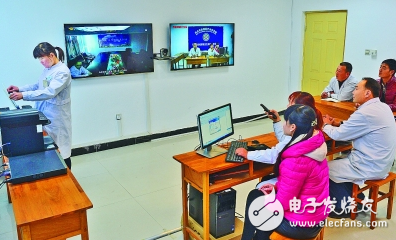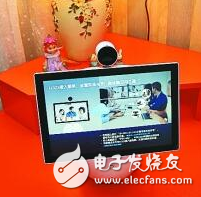There are no beds and doctors, only streamlined smart instruments, lightweight wearables and visual terminals. This is an “unmanned†medical hut. Qin Ping, a night-time editor of a newspaper, worked the day before in the early morning, and her head was groggy. She walked into the “unmanned†medical lodge, operated according to the equipment, and measured the blood pressure, blood lipids, blood sugar, and a diagnostic report. It is printed out and shows that the blood pressure is high. She presses the call button, the doctor appears on the big screen, through online communication, he analyzes Qin Ping's blood pressure due to overwork, it is recommended to rest properly, and monitor the blood pressure in the morning and evening for three consecutive days.
In the Xibaipo Township Health Center of Pingshan County, Shijiazhuang City, doctors at the Peking University People's Hospital passed the "Telemedicine Consultation Platform" to consult patients in the old district.

The “unmanned†medical lodge that Qin Ping experienced is the newly developed “cloud medical office†of Beijing Aerospace Center Hospital. It moves the health care port forward to people and is one of the rapidly developing telemedicine technology cases. Although telemedicine is not a new concept, with the development of communication technology and the development of artificial intelligence, wearable technology, big data, etc., its role in health care, chronic disease supervision and mitigation of medical resource imbalance is also More and more attention is being paid.

Let health care be moved to everyone
According to Liu Wei, chief expert of the Health Management Department of the Space Center Hospital, there is a sad story behind the birth of this “unmanned†medical lodge. Seven or eight years ago, Dr. Haigui, an important scientific and technological field in China, died in overtime. This not only makes his parents "white hair people send black hair", but also makes our country lose valuable scientific and technological talents.
“How to avoid similar tragedies from the perspective of health care?†Liu’s answer is that “the best time to treat is very important. As people work and their pace of life accelerates, the pressure on them increases accordingly, if at your fingertips. The local setting of self-help medical facilities allows everyone to easily check the health status, and believes that similar incidents can be largely avoided."
According to Zou Dianxin, honorary president of the China Medical Care Association Telemedicine Professional Committee, telemedicine, as a breakthrough and innovation in traditional medicine, has obvious advantages in health management and follow-up of chronic diseases. "Using the Internet, big data, and other means to use telemedicine in appropriate settings and in home health care can greatly reduce the time and cost of transporting patients and provide more timely and convenient medical services."
"As soon as the relevant technologies mature, people do not have to go to community hospitals or large hospitals in non-emergency telemedicine incidents." Guo Jun, deputy director of the Space Center Hospital, said, "Remote monitoring of blood pressure, blood sugar, and real-time through remote monitoring equipment. Blood oxygen, body temperature and other indicators, these data are uploaded in real time through the telemedicine platform, the doctors of the hospital can monitor these data for timely adjustment of patient medication or treatment.†She also said that due to economic conditions, poor people see a doctor for medical treatment. At the wrong time, the situation is serious. "It is often a small illness, a serious illness, and it is often found that the body has been damaged or has reached the advanced stage of malignant disease." "Telemedicine technology can initiate remote health monitoring, disease risk assessment and early warning mechanisms for the poor to a large extent, and intervene from the early stage of disease development to achieve early prevention, early detection and early treatment." Guo Jun said. From this perspective, telemedicine is to move the port of health care forward, to achieve a full range of full-cycle health care, and thus to reconstruct the patient's medical treatment.
Medical intelligence to alleviate resource imbalance
In addition to the “unmanned†medical hut, telemedicine can span space to enable doctors to “face-to-face†communication with patients. In Fuyuan County Chinese Medicine Hospital in Yunnan, a 78-year-old man was treated with He Shuibo, the chief physician of the Geriatrics Department at Beijing Space Center Hospital, 3,000 kilometers away from him. The signal was connected, and the image of the medical treatment thousands of miles away was projected on the display screen. The doctor in charge of Yunnan introduced the condition, the admission record, the electrocardiogram, the test list, and the CT image, and He Shuibo and the other two doctors consulted. The elderly who had been treated for half a year and whose condition suddenly deteriorated developed a targeted clinical treatment plan and gave daily nursing advice. This is the scene when the remote consultation of the Space Center Hospital was opened in April 2017. In January 2018, the range of mature telemedicine applications expanded. The Space Center Hospital Aerospace Specialist Medical Association and Ophthalmology Remote Clinic officially opened to the whole country. On the afternoon of the opening of the day alone, Ling Yu, the director of the ophthalmology department of the hospital, conducted a “remote diagnosis†on 23 ophthalmic patients in remote areas.
At present, the telemedicine hospital has carried out telemedicine, including remote clinical consultation, remote referral, remote imaging diagnosis, remote pathology diagnosis, remote ECG diagnosis, and remote health management. The desire of patients to "less errands and make good doctors to see a doctor" is gradually becoming a reality here.
In fact, telemedicine is indeed seen as a "profit" for scientific and technological progress to unravel the uneven development of medical resources. It uses networked information platform to connect medical institutions and patients in different regions to conduct medical activities such as cross-institutional and cross-regional medical diagnosis and medical professional communication. With the development of artificial intelligence technology and big data analysis, “less errands, Provincial road tolls, less queues, and time-saving medical care, with telemedicine technology, can really be enjoyed at home.
"From the perspective of the supply side, the shortage of quality medical service resources is very obvious. The high-profile medical treatment and expensive medical problems are largely due to scarcity of resources, uneven distribution and inefficiency, which has also led to medical intelligence. By introducing big data or artificial intelligence technology to improve the efficiency of medical services, and using remote technology to achieve space-time barrier-free medical treatment, it should be one of the key methods to solve the problem." Guo Jun said.
According to Zhang Xuegao, director of the Information and Statistics Center of the National Health and Family Planning Commission, telemedicine can integrate medical and health resources, optimize medical resource allocation, alleviate the problem of insufficient medical resources in China's health care industry, and accelerate the development of grassroots medical and health service system. And deepen the important driving force for the reform of the medical and health system.
"With the continuous deepening of medical reform, medical and health informationization has received more and more attention from the state. To this end, the Space Center Hospital has also established a telemedicine expert committee, which is to let more experts participate in the work of telemedicine, and promote And the development of aerospace system telemedicine system," said Du Jichen, president of the Space Center Hospital.
Is the "spring" of telemedicine coming?
Although the "unmanned" medical hut is very convenient, the advantages of telemedicine are obvious to all, but when will it come to everyone? In the view of Lu Qingjun, director of the Office of Telemedicine Management and Training Center of the National Health Planning Commission, telemedicine is a category of medical behavior, which is quite different from some consumer-oriented mobile phone applications. "Telemedicine is the behavior of medical personnel who take the medical knowledge he has obtained and provide care for patients." Lu Qingjun said, therefore, first of all, it must have strict technical standards, and the construction of information platform should conform to this technical standard to ensure data security. And quality, and more importantly, telemedicine management practices are consistent with all medical management regulations and systems.
From this point of view, it will take some time for telemedicine to benefit the public, but related work is gradually being carried out. According to Lu Qingjun, the National Health Planning Commission officially established the Telemedicine Management Training Center in 2012. The main task is to establish a national demonstration system, establish and study medical standards and management norms, and establish a medical quality control system throughout the country to train grassroots doctors. Clinical diagnosis and treatment capabilities. At present, the telemedicine platform network has covered 32 provinces and cities, more than 2,000 hospitals, and more than 60 disciplines have already started business on the platform.
"The hospital's discipline construction of medical care, education, scientific research, and disease prevention must be realized through the telemedicine platform. With such a platform, the disciplines and disciplines of lower-level hospitals and higher-level hospitals can be truly realized. This can better improve the work. Efficiency, medical quality and medical safety.†Lu Qingjun said, “Telemedicine is not only to solve consultation and consultation problems, but also to guide the referral. More importantly, it is a promotion and integration of all working situations in the hospital.â€
On the other hand, technological research pursuing more precise and convenient is also advancing. At present, the Institute of Automation of the Chinese Academy of Sciences has jointly established the China Aerospace Remote Medicine Sharing Laboratory with the Space Center Hospital, trying to use digital and informational methods to alleviate the problem of medical treatment through the combination of artificial intelligence and telemedicine. According to Xu Bo, director of the Institute of Automation, Chinese Academy of Sciences, the laboratory's research covers medical sensing, knowledge processing and question and answer, simulation surgery and service robots, cloud services and operating systems, and telemedicine research.
Guo Jun has a judgment. From the perspective of the industry itself, telemedicine has reached a stage of development in full swing. After decades of preparation, start-up and development, telemedicine has ushered in with the continuous updating of modern information technology. Your own spring, and all of this, can not be separated from the "joining" of the important role of technology. “I believe that more people will soon enjoy the convenience of telemedicine,†she said.
Fibre Optic Cable Joint Box,Outdoor Fiber Splice Box,Optical Fiber Cable Joint Box,Fusion Splice Box
Ningbo Fengwei Communication Technology Co., Ltd , https://www.fengweicommunication.com